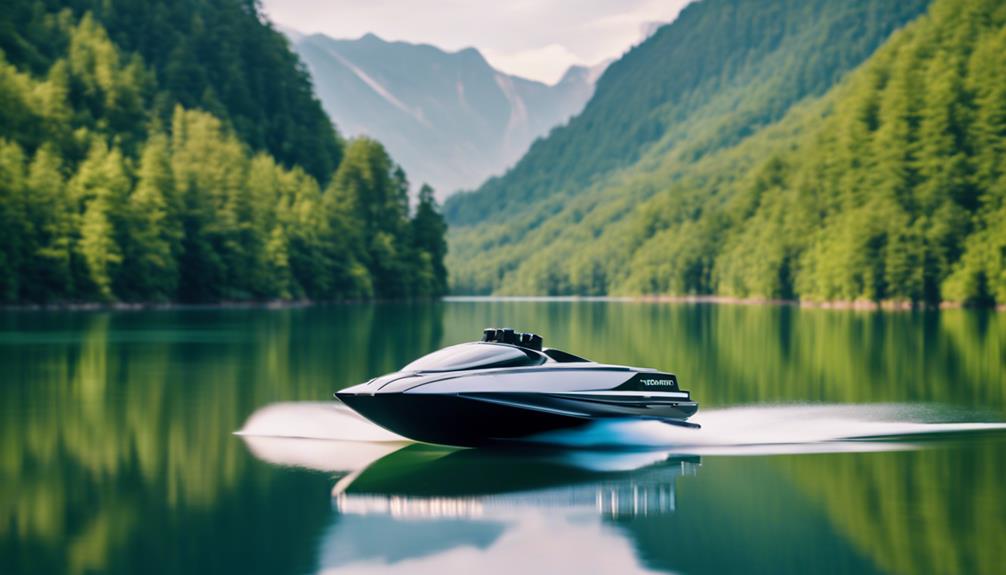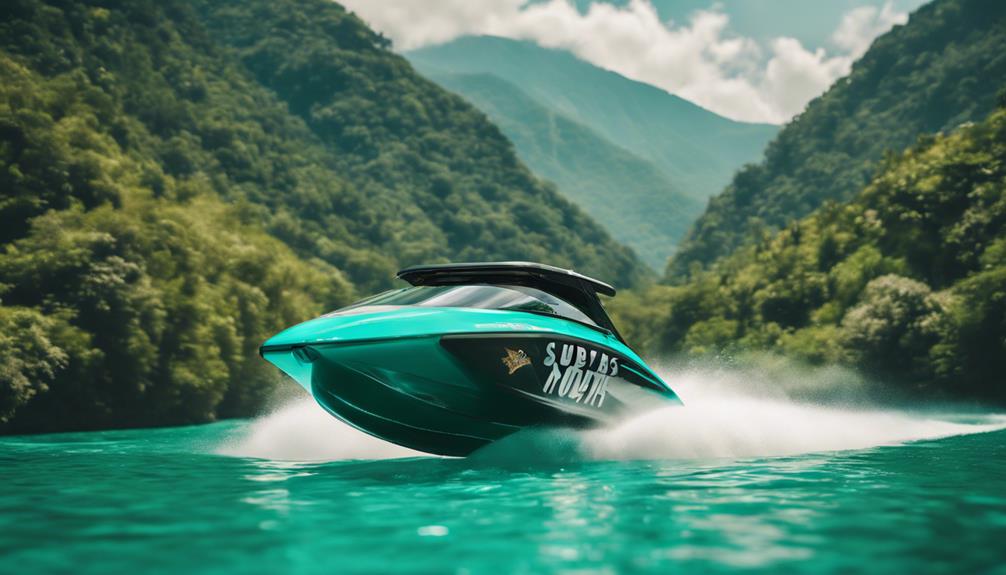Yes, jet boats do have a neutral position, and it's essential for your safety and maneuverability. This feature allows you to keep the boat stationary while boarding or docking, minimizing the risk of accidents. In neutral, you can fine-tune your positioning without drifting, which is especially helpful in tight spots or crowded waters. Some models even include electric motors for adjusting neutral easily. While you may experience slight forward movement at startup, managing this helps maintain control. There's much more to explore regarding jet boat operation and features, so keep going to discover what else you might find useful!
Key Takeaways
- Jet boats typically feature a neutral position that allows for stationary operation, crucial for safe boarding and docking.
- The neutral functionality enhances maneuverability in tight spaces, preventing unwanted drifting during low-speed navigation.
- Some jet boat models include electric motors for fine-tuning the neutral position, improving control during docking.
- Understanding the neutral position is essential for effective water navigation and maintaining control in crowded areas.
Understanding Jet Drive Mechanism
Jet boats utilize a bucket system that directs water flow, enabling precise control over forward and reverse motion. This innovative design is a key feature of jet drives, setting them apart from traditional propulsion systems. Rather than relying on propellers, jet boats draw in water and expel it through a nozzle, allowing for rapid changes in speed and direction.
One of the standout advantages of jet drives is their exceptional maneuverability. When you want to shift from forward to reverse, the bucket system allows for quick adjustments, letting you navigate tight spaces with ease. This responsiveness enhances your control, making it easier to steer and position the boat precisely where you need it.
In addition, the jet drive mechanism guarantees you can maintain stability while moving between forward and reverse. This is particularly useful when docking or making sharp turns. With the ability to direct water flow effectively, you can enjoy a smooth and agile boating experience.
Understanding how jet drives work is essential for mastering the art of operating a jet boat, so you can make the most of its impressive capabilities.
The Role of Neutral

Understanding the role of neutral in jet boats is essential for smooth maneuverability and safety.
You'll see that achieving neutral isn't just about stopping movement; it's vital for effective docking and maintaining your position on the water.
Let's explore how neutral functionality impacts your overall boating experience.
Neutral Functionality Explained
Neutral functionality in jet boats plays an important role in allowing you to control the vessel without moving, making it easier to board, disembark, and steer during docking procedures. The neutral position is essential for maintaining your stability while guaranteeing the engine runs smoothly without propulsion.
Here's how it helps:
- Safe Boarding and Disembarking: Being in neutral keeps the boat stationary, reducing the risk of slips or falls.
- Enhanced Control: You can maintain precise control during docking procedures, making sure you align the boat correctly with the dock.
- Maneuvering in Tight Spaces: The neutral position is fundamental for steering crowded or narrow waterways, allowing for fine adjustments without unwanted movement.
- Adjustable Neutral: Some jet boats feature electric motors that let you fine-tune the neutral position, enhancing operational ease.
Understanding the neutral position is important for effective steering. While slight forward movement during startup is normal, excessive movement signifies the need for adjustment.
Mastering this function guarantees you enjoy a safer, more controlled experience on the water.
Importance for Maneuverability
The ability to shift into neutral greatly enhances your maneuverability, allowing you to navigate tight spaces and execute precise movements with ease.
In jet boats, the neutral position is vital for maintaining control during docking procedures. When you're ready to dock or pick up passengers, being in neutral prevents the boat from drifting, ensuring a safe boarding or disembarking process.
Moreover, some jet boat models offer fine-tuning of the neutral position through electric motors. This feature gives you added control and comfort, especially when maneuvering at low speeds in crowded waterways. It's important to understand how to effectively use the neutral position to prepare for turns or stops without losing control.
Keep in mind that jet boats can exhibit slight forward movement during startup when in neutral, which may require adjustment. By mastering the neutral position, you'll find it markedly easier to navigate your jet boat, making every trip more enjoyable.
Whether you're maneuvering in a tight harbor or executing delicate docking procedures, the neutral position is your best ally for smooth and controlled handling.
Safety Considerations in Neutral
Using the neutral position effectively is vital for ensuring safety while boarding and disembarking on a jet boat. When you're in neutral, you maintain better control, reducing the risk of drifting and allowing for smoother docking maneuvers.
Here are some key safety considerations:
- Prevents Drifting: The neutral position helps keep the boat stationary, making it safer for passengers to board or disembark.
- Improves Control: You can easily manage the boat's position, especially in crowded or narrow waterways, enhancing overall safety during maneuvering.
- Facilitates Docking: Being in neutral during docking procedures allows for more precise positioning, minimizing the chance of collisions.
- Adjustments Awareness: If you notice excessive forward movement while in neutral, it might indicate that adjustments are needed for ideal control and safety.
Understanding how to use neutral effectively not only enhances your safety but also makes the experience more enjoyable.
Reverse Functionality Explained

When you're operating a jet boat, understanding the reverse mechanism is key to effective maneuvering.
The bucket system directs water flow backward, giving you the ability to reverse quickly, while the neutral position allows for smooth idling.
Knowing how these functions work together helps you navigate tight spaces with ease.
Jet Boat Reverse Mechanism
Jet boats feature a unique reverse mechanism that redirects water flow with a bucket, allowing for swift changes between forward and reverse motion. This innovative design enhances your boat's maneuverability, especially in tight spots.
Here's how the reverse functionality works:
- Water Redirection: The bucket or gate redirects water flow, creating reverse thrust for quick backward movement.
- Instant Shift: You can shift from forward to reverse almost instantly, making it easier to navigate crowded areas.
- Drive System Compatibility: Many modern jet boats use a sophisticated drive system that includes reverse gear mechanisms for improved control.
- True Neutral Capability: While in true neutral, the engine runs without propelling the boat, allowing you to idle or prepare for boarding without drifting.
Understanding the jet boat reverse mechanism is essential for effective maneuvering. It empowers you to handle your boat with confidence, ensuring you can respond rapidly to changing conditions on the water.
Whether you're docking or avoiding obstacles, this functionality can be a game-changer in your boating experience.
Importance of Neutral Position
The neutral position in jet boats is fundamental for guaranteeing safety and stability while boarding or disembarking, as it prevents unwanted drifting. When you're getting on or off, the neutral setting allows the engine operation without propelling the boat forward or backward, offering you the control you need in these situations.
Understanding the importance of this position is essential for effective maneuvering, especially in crowded or narrow waterways. In neutral, you can maintain your position without worrying about drifting away, which is significant when traversing busy areas. Some models even come with electric motors that fine-tune the neutral position, enhancing your control and stability during stationary operations.
While slight forward movement during startup is normal, excessive motion might indicate that adjustments are necessary to guarantee proper engine operation. Having a firm grasp of the neutral functionality not only boosts your confidence but also enhances your overall experience on the water.
Driving Experience Insights

Driving a jet boat offers a unique experience, blending easy steering with the ability to quickly switch between forward and reverse thanks to its innovative bucket system. This design enhances your driving experience, making it feel more like a sports car than a traditional vessel.
Here are some insights to reflect on:
- Easy Steering: You'll find that steering is more responsive and requires minimal movement, allowing for quick adjustments.
- Neutral Position: The bucket system provides a neutral position, letting you maintain control while idling, perfect for docking or boarding.
- Throttle Control: You might notice that throttle control can be a bit different from traditional boats, especially at idle speeds, which can feel faster due to water spray.
- Maneuverability: Jet boats excel in tight spaces, allowing you to navigate with ease compared to propeller-driven boats.
Safety and Handling Considerations

Maneuvering a jet boat requires attention to safety and handling, especially when utilizing the bucket system to maintain control while idling. This system allows you to achieve a neutral position, which is vital for safe boarding and docking procedures.
However, keep in mind that when starting up, you might experience slight forward movement, so adjust your throttle control to prevent excessive drift. Jet boats generally idle at higher speeds compared to traditional boats, so it's important to maintain no-wake speeds in designated zones.
Their enhanced maneuverability in neutral makes it easier for you to navigate tight spaces and crowded areas, providing greater control even when stationary. One of the key safety features of jet boats is the absence of an exposed propeller, greatly reducing the risk of injuries during boarding and water activities.
This makes jet boats a safer choice for families. Ultimately, understanding these safety and handling considerations will help you enjoy a more secure and enjoyable boating experience, ensuring that you can focus on the fun while staying safe on the water.
Key Factors for Potential Buyers

When considering a jet boat, understanding how its unique neutral system enhances control during docking and boarding is vital for a smooth experience on the water. Unlike traditional boats, jet boats use a bucket system to achieve a neutral position, allowing the engine to run without propelling the boat. This feature is fundamental for maneuverability in tight spaces.
Here are four key factors to keep in mind:
- Enhanced Control: The neutral position gives you better steering capabilities during docking, making it easier to navigate crowded marinas.
- Fine-Tuning Options: Some jet boats offer electric motors for adjusting the neutral position, providing you with ideal control during stationary operations.
- Forward Movement: Be aware that while in neutral, jet boats may still exhibit slight forward movement, so adjustments might be necessary.
- Idle Speed: Jet boats idle at higher speeds than traditional boats, which can affect your control in busy waterways.
Understanding these factors will help you make an informed decision and guarantee a more enjoyable boating experience.
Frequently Asked Questions
Do Jet Boats Have Neutral?
Jet boats don't have a traditional neutral gear. Instead, you can achieve a neutral position using a bucket system, which lets the engine run while keeping the boat stationary, essential for safe boarding or disembarking.
What Are the Downsides of Jet Boats?
You'd think jet boats are all about speed and excitement, but their lack of neutral can confuse you. Plus, noisy engines and tricky maneuvering at low speeds might not be as thrilling as you imagined.
How Safe Are Jet Boats?
Jet boats are generally safe due to their lack of exposed propellers, which minimizes injury risks. Their design allows for better deck space and safer activities, making them a popular choice for family outings and water sports.
Are Jet Boats Good in Rough Water?
You might think jet boats struggle in rough water, but they actually excel with agile handling and quick acceleration. Just remember, while they perform well, caution's still essential in extreme conditions to guarantee safety.
Is the Ability to Go into Neutral Mode a Factor in Jet Boat Safety?
When considering jet boat safety facts, the ability to go into neutral mode is indeed a crucial factor. Being able to quickly switch to neutral can help in avoiding potential accidents or collisions, especially in crowded waterways. It allows for better maneuverability and control, ultimately enhancing overall safety on the water.
Does the Noise Level of Jet Boats Affect Their Ability to Go into Neutral?
Jet boat noise levels can indeed affect their ability to go into neutral. Excessive noise can make it difficult for the operator to accurately gauge the engine speed, impacting their ability to shift into neutral smoothly. Therefore, it is important to consider the noise levels of jet boats when operating them.
Conclusion
In summary, while jet boats typically lack a traditional neutral gear, understanding their unique mechanics allows you to navigate effectively.
Imagine seamlessly shifting from forward to reverse without the need for neutral—this is the beauty of jet propulsion.
As you consider investing in a jet boat, weigh the driving experience, safety features, and handling nuances to guarantee it aligns with your boating lifestyle.
Embrace the thrill of the ride while staying informed about your vessel's capabilities.










